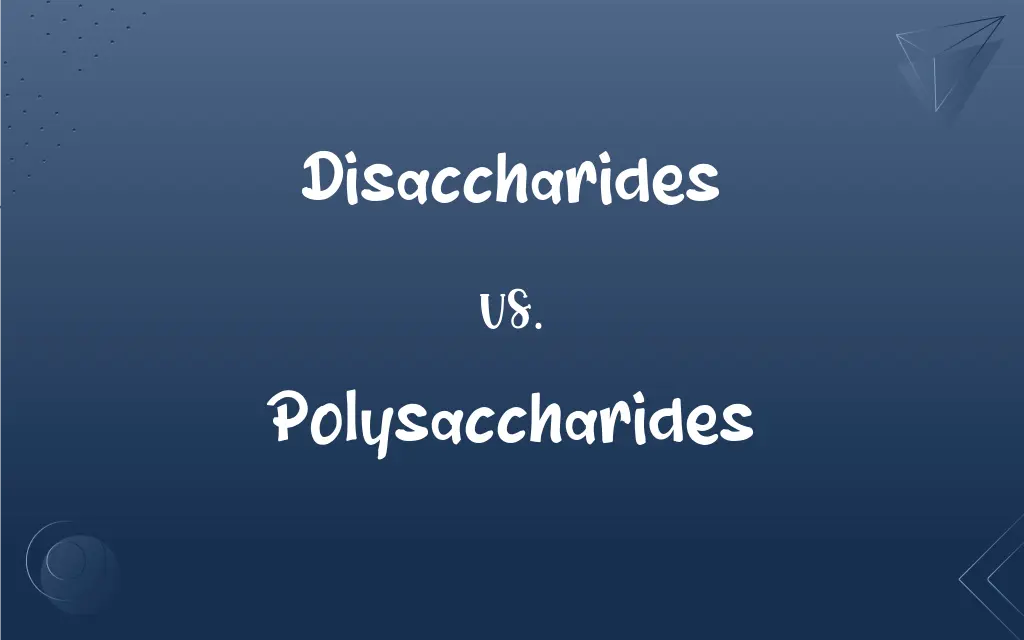Disaccharides vs. Polysaccharides: What's the Difference?
Edited by Aimie Carlson || By Harlon Moss || Updated on October 27, 2023
Disaccharides are sugars composed of two monosaccharides, while polysaccharides are long chains of monosaccharide units.

Key Differences
Disaccharides are a specific type of carbohydrate formed when two monosaccharide molecules bond together. Common examples of disaccharides include sucrose, lactose, and maltose. These sugars are found naturally in various foods and are often involved in the sweet taste we associate with candies, fruits, and certain dairy products. Polysaccharides, conversely, are complex carbohydrates made up of multiple monosaccharide units that are connected in long chains or branches.
The distinction between disaccharides and polysaccharides is primarily in their structural complexity and their functional roles in organisms. Disaccharides, given their simpler structure, typically play roles in immediate energy provision and transport. On the other hand, polysaccharides can serve as both energy storage molecules (like starch and glycogen) and structural components (like cellulose in plants).
Digestion processes also differ between disaccharides and polysaccharides. Disaccharides need to be broken down into their constituent monosaccharides before absorption in the gut. Polysaccharides require a more prolonged digestive process, breaking the long chains into simpler sugars which can then be absorbed.
In terms of solubility, disaccharides generally dissolve well in water, leading to their sweetness when consumed. Polysaccharides, being larger molecules, might be less soluble and don't typically have a sweet taste. For instance, while sucrose (a disaccharide) tastes sweet, cellulose (a polysaccharide) is tasteless and serves structural functions in plants.
Comparison Chart
Complexity
Composed of two monosaccharides.
Composed of many monosaccharide units.
ADVERTISEMENT
Function
Immediate energy provision and transport.
Energy storage and structural functions.
Solubility
Generally soluble in water.
Less soluble; varies based on type.
Taste
Typically sweet.
Typically not sweet.
Digestion
Quickly broken down into monosaccharides.
Requires prolonged digestion into simpler sugars.
Disaccharides and Polysaccharides Definitions
Disaccharides
Sugars that consist of two linked simple sugars.
Lactose intolerance is due to the inability to digest the disaccharide lactose.
ADVERTISEMENT
Polysaccharides
Complex sugars made up of more than two monosaccharide molecules.
Cellulose, a major component of plant cell walls, is a polysaccharide.
Disaccharides
Simple carbohydrates derived from the combination of two singular sugar molecules.
The sweetness of table sugar is due to the disaccharide sucrose.
Polysaccharides
Large carbohydrate molecules consisting of numerous simple sugar units.
Glycogen is a polysaccharide that serves as an energy reserve in animals.
Disaccharides
Dual-unit sugars that can be hydrolyzed into two simpler sugars.
Bees convert nectar into the disaccharide, sucrose.
Polysaccharides
Carbohydrates with long chains of monosaccharide units.
Starch is a polysaccharide used by plants to store energy.
Disaccharides
Carbohydrates made up of two monosaccharide molecules.
Sucrose is one of the most common disaccharides in our diet.
Polysaccharides
Extended sugar chains or branches derived from numerous simple sugar building blocks.
The thickening property of certain foods comes from the polysaccharide known as pectin.
Disaccharides
Double sugars resulting from the condensation of two monosaccharides.
Maltose is a disaccharide formed from two glucose molecules.
Polysaccharides
Macro molecules formed from multiple linked monosaccharides.
The hard shell of crustaceans contains chitin, a type of polysaccharide.
Disaccharides
Plural of disaccharide
Polysaccharides
Any of a class of carbohydrates, such as starch and cellulose, consisting of a number of monosaccharides joined by glycosidic bonds.
Polysaccharides
Plural of polysaccharide
FAQs
How are polysaccharides different from simple sugars?
Polysaccharides are complex carbohydrates made of many monosaccharide units.
Which is sweeter, disaccharides or polysaccharides?
Disaccharides typically have a sweeter taste.
What are disaccharides made of?
They're made of two monosaccharide molecules.
Are polysaccharides digestible?
Some, like starch, are digestible, but others, like cellulose, aren't by humans.
Are all polysaccharides insoluble in water?
No, some are soluble, but many are less soluble than disaccharides.
Is lactose a sugar found in milk?
Yes, lactose is a disaccharide found in milk.
Can disaccharides be found in plants?
Yes, sucrose is a common disaccharide in many plants.
Is starch a disaccharide or polysaccharide?
Starch is a polysaccharide.
Why can't humans digest cellulose?
Humans lack the enzyme to break down the beta-linkages in cellulose.
Is maltose a product of starch breakdown?
Yes, maltose is produced during starch digestion.
Which is more complex, disaccharides or polysaccharides?
Polysaccharides are more complex.
Which polysaccharide is found in animal liver?
Glycogen is the storage polysaccharide in animal liver.
Can the body quickly use disaccharides for energy?
Yes, once they are broken down into monosaccharides.
Are all polysaccharides energy storage molecules?
No, some, like cellulose, have structural roles.
What are some examples of disaccharides?
Sucrose, lactose, and maltose are examples.
How are disaccharides formed?
By the condensation of two monosaccharides.
Do both disaccharides and polysaccharides have a storage function?
While some disaccharides can be stored, polysaccharides primarily serve this function.
Can the body use polysaccharides directly for energy?
No, they must be broken down into simpler sugars first.
Is the bond between two monosaccharides in a disaccharide covalent?
Yes, it's a covalent bond known as a glycosidic linkage.
Why are polysaccharides ideal for storage?
Their large size and insolubility make them ideal for long-term energy storage without affecting cell osmolarity.
About Author
Written by
Harlon MossHarlon is a seasoned quality moderator and accomplished content writer for Difference Wiki. An alumnus of the prestigious University of California, he earned his degree in Computer Science. Leveraging his academic background, Harlon brings a meticulous and informed perspective to his work, ensuring content accuracy and excellence.
Edited by
Aimie CarlsonAimie Carlson, holding a master's degree in English literature, is a fervent English language enthusiast. She lends her writing talents to Difference Wiki, a prominent website that specializes in comparisons, offering readers insightful analyses that both captivate and inform.
































































